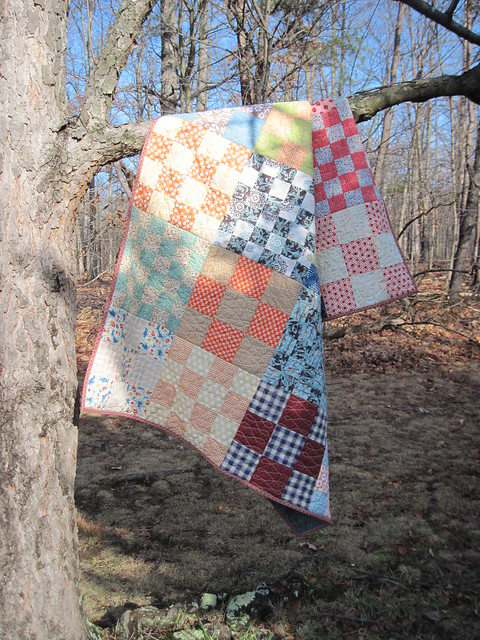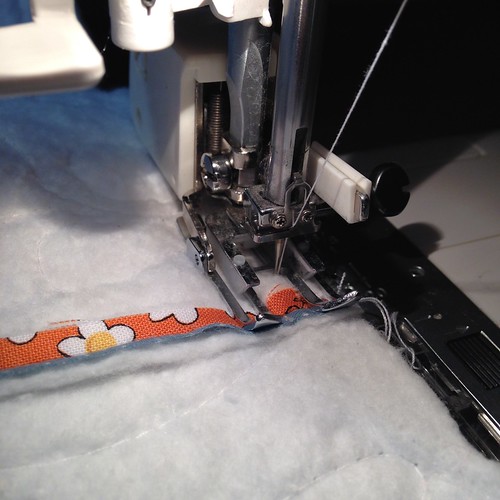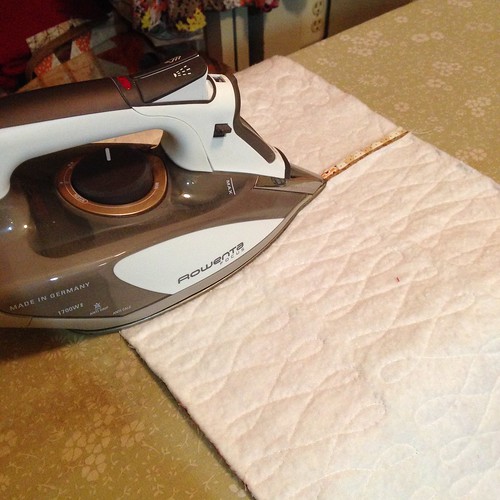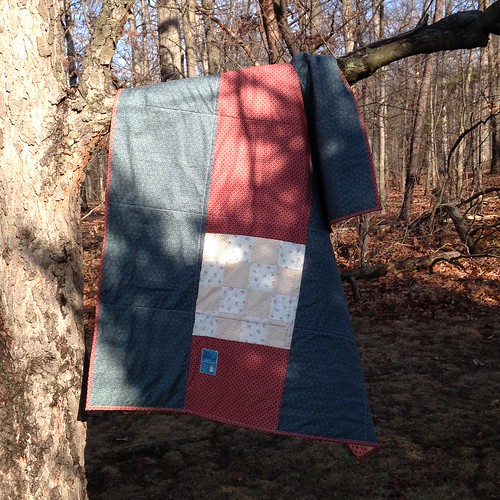 |
| Great Grandmother's Quilt - a Quilt as You Go quilt |
When I first contemplated using QAYG I did some searching online to see how others have used this method. There are several good tutorials out there with varying degrees of difficulty for assembling the quilt top. Because the quilt I was working on was for do. Good Stitches I also wondered if there was any prohibition against using QAYG. However, as part of my research I discovered that Rachel (Stitched in Color), the CEO of do. Good Stitches, used it for one of the quilts she made as part of the Love Circle of do. Good Stitches. Rachel's method is straightforward - not requiring any fussy sashing to cover the joining of the blocks so I opted to use her method.
Here's an overview of what I did to finish my Great Grandmother's Quilt (be sure to check out Rachel's post if you want the full tutorial).
First I used my rotary cutter to square up all the quilt blocks once they were quilted. I did loose a bit of the overall size due to the different quilt patterns on the various blocks, but having uniform size to the blocks is always a good thing. The next step was simply to sew the blocks together.
First I used my rotary cutter to square up all the quilt blocks once they were quilted. I did loose a bit of the overall size due to the different quilt patterns on the various blocks, but having uniform size to the blocks is always a good thing. The next step was simply to sew the blocks together.
 |
| Sewing the quilted blocks together - still no backing fabric |
Because the blocks were nicely squared up it was an easy process to sew them together. Next came pressing all the seams.
Okay, I will admit this was one of my least favorite stages of the assembly process. Generally I enjoy ironing and almost always choose to iron my seams open. I will just come out and say that an iron does not glide enjoyably across batting - there is a certain amount of drag. Also, since I was ironing both fabric and batting it was harder to get a 1/4" seam to want to stay open, but due to the bulk involved it was not an option to press the seams to the side. As a side note: It is very important to use natural (cotton or wool) batting because of the iron directly on the batting when pressing seams open.
Once the top is complete the back is simply added on and you stitch in the ditch along the horizontal and vertical seams to attach it. If you look carefully in the picture below you can see the grid pattern used to attach the quilt backing fabric.
As you can see it creates a grid that is almost 12" square. Since the batting is securely quilted to the quilt top you don't have to be concerned about this large unquilted area on the quilt back. In her blog post Rachel suggests using zigzag stitching for this stitching in the ditch. I tried that for about one block length and then ripped it out. I could not imagine zigzagging all over this quilt and instead chose to just use straight line stitching. Edited to add: Surprisingly, you really don't notice any bulk from the quilted seams-not on the front or the back of the quilt. This was one area I was concerned about.
Okay, here's my final thoughts. Did I like using the Quilt as You Go method? For the actual quilting of the blocks I loved it! It was so very easy to quilt an individual block instead of wrestling with an entire quilt top. For the attaching of the back? Well, it certainly could not be much easier than this process, but to be honest I am just okay with the way it looks. Often the back of a quilt will show off the pretty quilting better than a busy quilt front. The back also does not get that yummy just-out-of-the-dryer crinkled look without dense quilting. That being said, would I use this method again? Yes, I think so, but it will really depend on who the recipient of the quilt is.
All in all this was a great opportunity to build up my free motion quilting confidence and give a new construction method a try. Next time I may try using one of the sashing methods to join blocks - but we'll see :o)
 |
| Ironing the seams open |
Okay, I will admit this was one of my least favorite stages of the assembly process. Generally I enjoy ironing and almost always choose to iron my seams open. I will just come out and say that an iron does not glide enjoyably across batting - there is a certain amount of drag. Also, since I was ironing both fabric and batting it was harder to get a 1/4" seam to want to stay open, but due to the bulk involved it was not an option to press the seams to the side. As a side note: It is very important to use natural (cotton or wool) batting because of the iron directly on the batting when pressing seams open.
Once the top is complete the back is simply added on and you stitch in the ditch along the horizontal and vertical seams to attach it. If you look carefully in the picture below you can see the grid pattern used to attach the quilt backing fabric.
 |
| This picture shows the stitching that attaches the backing fabric |
As you can see it creates a grid that is almost 12" square. Since the batting is securely quilted to the quilt top you don't have to be concerned about this large unquilted area on the quilt back. In her blog post Rachel suggests using zigzag stitching for this stitching in the ditch. I tried that for about one block length and then ripped it out. I could not imagine zigzagging all over this quilt and instead chose to just use straight line stitching. Edited to add: Surprisingly, you really don't notice any bulk from the quilted seams-not on the front or the back of the quilt. This was one area I was concerned about.
Okay, here's my final thoughts. Did I like using the Quilt as You Go method? For the actual quilting of the blocks I loved it! It was so very easy to quilt an individual block instead of wrestling with an entire quilt top. For the attaching of the back? Well, it certainly could not be much easier than this process, but to be honest I am just okay with the way it looks. Often the back of a quilt will show off the pretty quilting better than a busy quilt front. The back also does not get that yummy just-out-of-the-dryer crinkled look without dense quilting. That being said, would I use this method again? Yes, I think so, but it will really depend on who the recipient of the quilt is.
All in all this was a great opportunity to build up my free motion quilting confidence and give a new construction method a try. Next time I may try using one of the sashing methods to join blocks - but we'll see :o)

ok. You answered several of my questions about this technique. Thank you! I think I feel the same as you about the look of the back, but overall it seems a reasonable consideration for some quilts. Thanks for sharing!
ReplyDeleteI have an ironing cotton! So I QAYG then when I iron seams I have a thin layer of quilting cotton that I put in the batting so that it's easier to iron! Totally helps! I'm doing a really big QAYG quilt now. Trying to keep the seams larger than 1/4", but not possible in some spots! Looks great!
ReplyDeleteI found your blog very informative and interesting. Thanks for sharing this. It would be a great tool to use with random leftover blocks as well.
ReplyDeleteThanks so much! It's fun to try new things and be able to share our experiences. I agree - this would be a great way to use up leftover/orphan quilt blocks :o)
DeleteI echo what the other Debbie has said above. Not for every project, but certainly worth trying. Thanks for sharing. Of course, when you try the other method (the one where your block has a backing as well and you assemble them with narrow strips - I think - ??) you`ll have to tell us about that too ;)
ReplyDeleteVery Interesting. Thanks For The Explanation.
ReplyDeleteNice to know what you thought of it! Thanks for sharing!
ReplyDeleteThis turned out so beautiful! I've used several QAYG methods, the one you described being my most recent technique and the one I've sort of 'settled into'. It's great for baby quilts and throws. I also like the look of skinny sashing strips and have used that technique, but it's more work :)
ReplyDelete